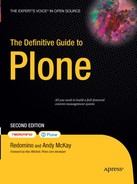When The Definitive Guide to Plone first arrived on bookshelves in 2004, Plone 2.0 had just been released and had little notable open source competition. The first edition of The Definitive Guide provided a truly comprehensive overview of the features of this early version of Plone and brought many new users to Plone. It was a major landmark for Plone and for open source content management systems (CMSs) in general. In the intervening years, the open source CMS universe has expanded rapidly. There are now dozens of competing open source CMSs, from humble blogging platforms to flexible enterprise-capable systems. Through all of this, Plone has managed to innovate, expand its vibrant community, and remain a vital, flexible, and popular CMS.
Since the publication of the first edition, the Plone community has produced a number of major revisions to the Plone CMS. Many new books have been published covering Plone from different perspectives (developers, administrators, and end users), but few have provided the comprehensive treatment provided by this book's first edition. Thankfully, Redomino, a successful Italian Plone consultancy, has updated The Definitive Guide so that this landmark book remains—true to its title—definitive. This updated volume reflects the many changes to Plone's user interface, nomenclature, and infrastructure. Redomino has asked me to provide a brief overview of Plone's recent evolution from the perspective of someone involved directly in the development and release of Plone during this period of change. The following is a brief summary of the major Plone releases since the original publication of The Definitive Guide to Plone, reflecting the new features covered in this edition.
Plone 2.1
The primary goal of this release was to convert all of the built-in Plone content types to use the Archetypes framework. This was a dramatic change to Plone's infrastructure, but one that made it much easier for developers to customize and extend the built-in types. By this point, Archetypes was in wide use among third-party developers; making the core types utilize the framework most used by the Plone developer community brought major advantages. Additionally, the user interface was significantly improved; this included moving many configuration tasks out of the ZMI and into Plone's control panels. Plone 2.1 also included a number of new features, such as selectable default pages, an improved Collection type (originally called Topics, and later Smart Folders), and Ajax LiveSearch.
Plone 2.5
This release focused almost entirely on infrastructure improvements. Though the outward appearance of Plone changed little for this release, there were a number of major internal changes that laid the groundwork for future improvements. Perhaps the most significant of these was support for using the Zope 3 framework when developing add-on products. The existing authentication and user management system was replaced with a more flexible version called the Pluggable Authentication System. This release also included support for locally customizable workflow policies.
Plone 3.0
Plone 3.0 arrived with a huge array of new features. A new portlet engine was added, providing tremendous flexibility in portlet definition and assignment. The user interface was redesigned, making heavy use of customizable Zope 3 "viewlet" components. Many improvements to the user interface were made, particularly to the administration control panels. The KSS Ajax framework was added, providing inline editing support and other dynamic user interface features. Additionally, this release included support for keeping a full revision history and for locking content during editing. It also added a content rules engine—allowing users to assign custom behaviors triggered by system events; these features greatly improved collaborative editing in Plone.
Post-3.0
There have been two subsequent releases, 3.1 and 3.2, since the tremendous milestone of Plone 3.0. These releases have had a somewhat limited scope; nonetheless, many interesting changes have happened during this time. Most significantly, the Plone community has standardized on zc.buildout for installing and deploying Plone, and WSGI has been gaining popularity as a means of integrating Plone with other Python applications and technologies.
This new edition of The Definitive Guide to Plone provides a much-needed update to the comprehensive view of the original. It covers everything from basic installation and setup tasks to advanced Python customizations, and has been updated to reflect Plone in its current—greatly improved—state. Hopefully, it will guide you to success in all your content management endeavors.
Alec Mitchell
Plone Core Developer
